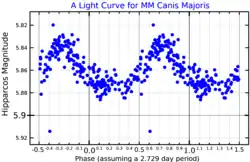| Observation data Epoch J2000 Equinox J2000 | |
|---|---|
| Constellation | Canis Major |
| Right ascension | 07h 12m 12.21483s[2] |
| Declination | −25° 56′ 33.3107″[2] |
| Apparent magnitude (V) | 5.89[3] or (5.84 – 5.87)[4] |
| Characteristics | |
| Spectral type | B2 IV/V[5] |
| B−V color index | −0.170±0.004[6] |
| Variable type | SPB[4] |
| Astrometry | |
| Radial velocity (Rv) | +21.6±2.9[6] km/s |
| Proper motion (μ) | RA: −5.678[2] mas/yr Dec.: +8.929[2] mas/yr |
| Parallax (π) | 3.2442 ± 0.0841 mas[2] |
| Distance | 1,010 ± 30 ly (308 ± 8 pc) |
| Absolute magnitude (MV) | −1.11[6] |
| Details | |
| Mass | 5.5±0.9[7] M☉ |
| Radius | 3.25[3] R☉ |
| Luminosity | 1,000+995 −499[7] L☉ |
| Surface gravity (log g) | 3.777±0.027[8] cgs |
| Temperature | 16,157±200[8] K |
| Rotation | 2.729±0.001[7] |
| Rotational velocity (v sin i) | 64±14[8] km/s |
| Age | 3.6±3.3[9] Myr |
| Other designations | |
| Database references | |
| SIMBAD | data |
26 Canis Majoris is a variable star in the southern constellation of Canis Major,[10] located around 1,010 light years away from the Sun.[2] It has the variable star designation MM Canis Majoris; 26 Canis Majoris is the Flamsteed designation.[10] This object is visible to the naked eye as a dim, blue-white hued star with a baseline apparent visual magnitude of 5.89.[3] It is moving further from the Earth with a heliocentric radial velocity of +22 km/s.[6]
With a stellar classification of B2 IV/V,[5] it appears as a B-type main-sequence star intermixed with traits of an evolving subgiant star. Samus et al. (2017) classify it as a slowly pulsating B-type variable star (SPB), which ranges from magnitude 5.84 down to 5.87 with a rotationally-modulated period of 2.72945 days.[4] Briquet et al. (2007) describe it as a chemically peculiar He-variable star, having inhomogeneous distributions of chemical elements across its surface. It has a variable, quasi-dipolar magnetic field, resulting in variations of the magnetic field and line strengths as it rotates.[7]
This star is around 3.6[9] million years old with a rotation period of 2.7 days.[7] It has 5.5[7] times the mass of the Sun and 3.25[3] times the Sun's radius. The star is radiating 1,000[7] times as much luminosity as the Sun from its photosphere at an effective temperature of 16,157 K.[8]
References
- ↑ Aerts, C.; De Cat, P.; Peeters, E.; Decin, L.; De Ridder, J.; Kolenberg, K.; Meeus, G.; Van Winckel, H.; Cuypers, J.; Waelkens, C. (March 1999). "Selection of a sample of bright southern Slowly Pulsating B Stars for long-term photometric and spectroscopic monitoring". Astronomy & Astrophysics. 343: 872–882. Bibcode:1999A&A...343..872A. Retrieved 15 November 2021.
- 1 2 3 4 5 6 Brown, A. G. A.; et al. (Gaia collaboration) (August 2018). "Gaia Data Release 2: Summary of the contents and survey properties". Astronomy & Astrophysics. 616. A1. arXiv:1804.09365. Bibcode:2018A&A...616A...1G. doi:10.1051/0004-6361/201833051. Gaia DR2 record for this source at VizieR.
- 1 2 3 4 Shulyak, D.; et al. (2014), "Interferometry of chemically peculiar stars: Theoretical predictions versus modern observing facilities", Monthly Notices of the Royal Astronomical Society, 443 (2): 1629, arXiv:1406.6093, Bibcode:2014MNRAS.443.1629S, doi:10.1093/mnras/stu1259, S2CID 96452769.
- 1 2 3 Samus, N. N.; et al. (2017), "General Catalogue of Variable Stars", Astronomy Reports, 5.1, 61 (1): 80–88, Bibcode:2017ARep...61...80S, doi:10.1134/S1063772917010085, S2CID 125853869.
- 1 2 Houk, Nancy; Smith-Moore, M. (1978), Michigan catalogue of two-dimensional spectral types for the HD stars, vol. 4, Ann Arbor: Dept. of Astronomy, University of Michigan, Bibcode:1988mcts.book.....H.
- 1 2 3 4 Anderson, E.; Francis, Ch. (2012), "XHIP: An extended hipparcos compilation", Astronomy Letters, 38 (5): 331, arXiv:1108.4971, Bibcode:2012AstL...38..331A, doi:10.1134/S1063773712050015, S2CID 119257644.
- 1 2 3 4 5 6 7 Briquet, M.; et al. (January 2007), "Discovery of magnetic fields in three He variable Bp stars with He and Si spots", Astronomische Nachrichten, 328 (1): 41–45, arXiv:astro-ph/0610537, Bibcode:2007AN....328...41B, doi:10.1002/asna.200610702, S2CID 18724568.
- 1 2 3 4 Huang, W.; et al. (2010), "A Stellar Rotation Census of B Stars: From ZAMS to TAMS", The Astrophysical Journal, 722 (1): 605–619, arXiv:1008.1761, Bibcode:2010ApJ...722..605H, doi:10.1088/0004-637X/722/1/605, S2CID 118532653.
- 1 2 Tetzlaff, N.; Neuhäuser, R.; Hohle, M. M. (January 2011), "A catalogue of young runaway Hipparcos stars within 3 kpc from the Sun", Monthly Notices of the Royal Astronomical Society, 410 (1): 190–200, arXiv:1007.4883, Bibcode:2011MNRAS.410..190T, doi:10.1111/j.1365-2966.2010.17434.x, S2CID 118629873.
- 1 2 3 "26 CMa". SIMBAD. Centre de données astronomiques de Strasbourg. Retrieved May 1, 2019.
